Singapore: Who Will Beat the Heat?
This newsletter covers the F1 race in Singapore and kicks off our coverage of the final seven races of the Formula 1 World Championship.
At a Glance
Setting the Stage
Welcome to the first edition of our F1 coverage on the Road to Abu Dhabi. Over the final stretch of the season, from Singapore through Austin, Mexico City, Brazil, Las Vegas, Qatar, and ultimately Abu Dhabi, we’ll be breaking down each Grand Prix with custom data stories, predictive models, and fresh insights into drivers and teams.
Our goal is to go beyond the headlines, highlighting the unique factors that shape every race: whether it’s the climate, the circuit type and layout, or the strategies that decide who comes out on top. Along the way, we’ll track championship battles, spotlight key drivers, and keep an eye on the drama both on and off the track.
Be sure to also check out our Instagram site for regular updates and posts on our F1 coverage.
The Hidden Rival
Going into Singapore, our model framed the race around one core antagonist: the heat. To assess its impact, we gathered temperature and performance data from every Formula 1 race over the past five years. Our analysis showed that every 1°C rise in temperature corresponded with roughly a 470-millisecond increase in lap time and about a 2-minute 23-second increase in total race time. In a sport where margins are often measured in tenths of a second, those numbers made Singapore’s 29°C+ climate a defining factor.
The scatter plot below shows the relationship between track temperature and lap times across recent races. Each point represents a Grand Prix, and the upward-sloping trend line highlights that as average race-day temperatures increase, average lap times per kilometer also rise. It’s a clear reminder that in Singapore, the heat isn’t just background noise, it’s a defining force that shapes the outcome of the race and pushes drivers to their limits.
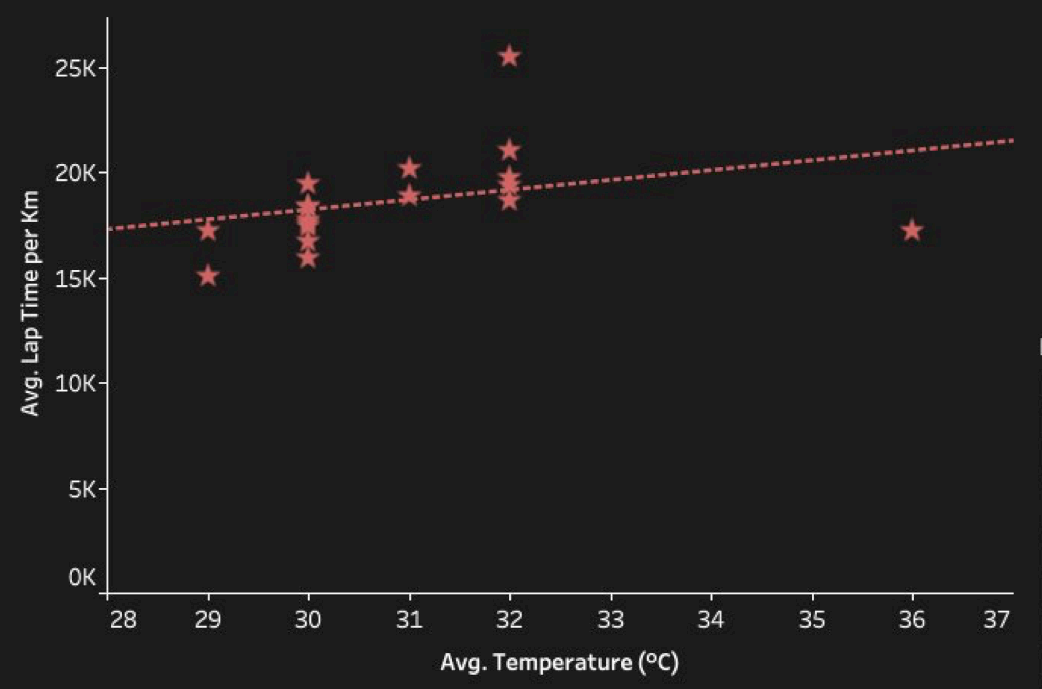
Want to learn how to analyze data and build amazing data stories? Join Data Punk Media today!
The Drive Score
To capture how individual drivers cope with race conditions, we've developed a new performance metric called the Drive Score. This measure was designed to evaluate the quality of a drive, not just the finishing position. It combines qualifying performance, final race results, and positional changes over the course of a weekend – with added weight given to moves at the sharp end of the field. For instance, moving from 4th to 2nd counts more than advancing from 10th to 8th, even though both represent a two-position gain. Beyond that, the Drive Score incorporates each driver’s track record at Singapore, their consistency in hot-weather races above 29°C, and their current performances from the 2025 season.
The chart below shows the top 10 drivers based solely on their total Drive Scores at the Singapore Grand Prix from 2022 to 2024. These totals reflect performance only at this circuit across the past three races. Our model, however, used a broader and more dynamic approach – weighting results from the 2025 season, hot-weather races, and past Singapore performances. Because of that, the leaderboard below doesn’t align exactly with our race predictions but provides valuable context on who has historically performed best at Marina Bay.
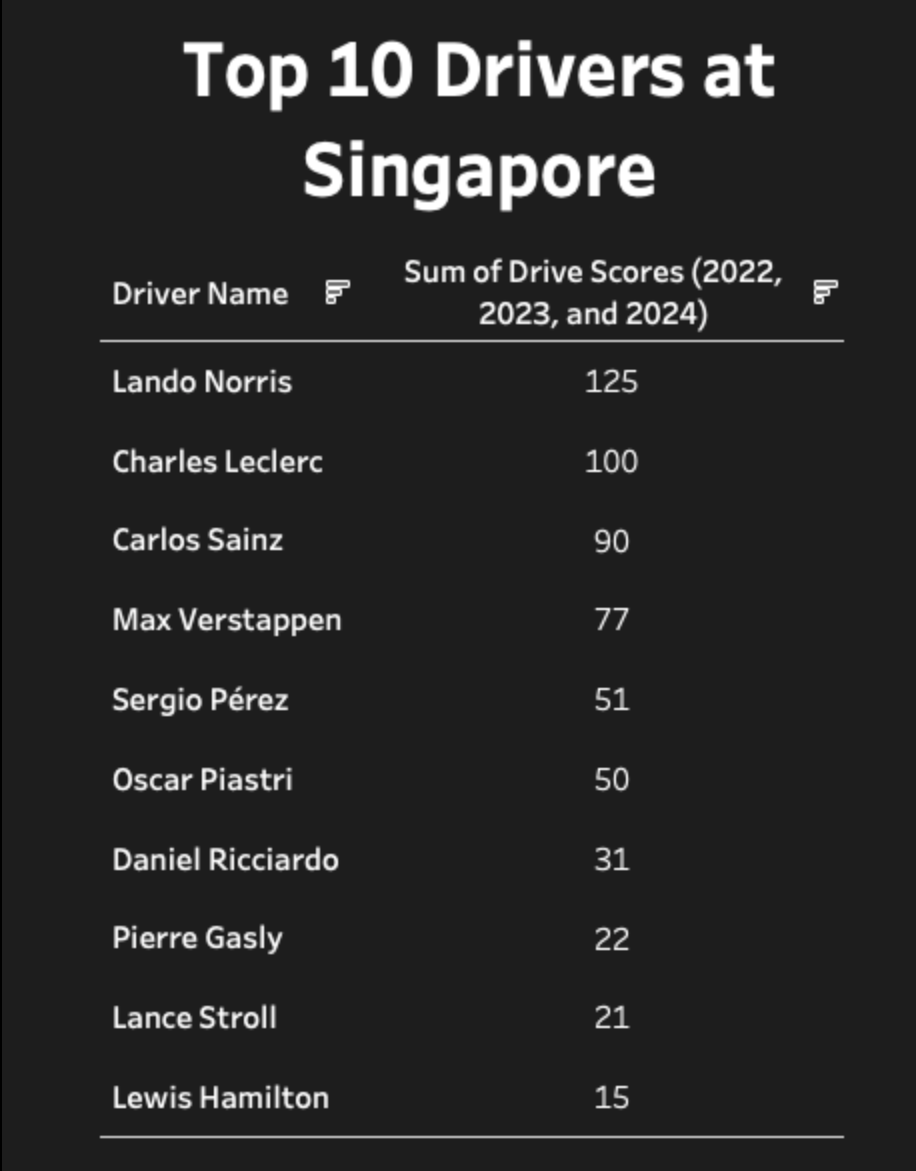
By blending these elements, the Drive Score offers a fuller picture of who might adapt under pressure, manage tire degradation, and sustain performance in extreme conditions. For Singapore, it means our projections emphasize a driver's pace, resilience and racecraft (totality of a racer's skill) required to beat the heat under the lights.
Who Will Beat the Heat
While the Singapore-only Drive Score rankings highlight drivers’ past results at this circuit, our model went further by incorporating data from recent seasons and high-temperature races. This combined weighting gave a more complete picture of current form and adaptability, leading to our final race projections. Based on the Drive Score and its emphasis on heat-adjusted performance, our model identified four drivers with the strongest chance of mastering the Marina Bay Street circuit. Max Verstappen and Charles Leclerc were virtually tied in our projections, both contending closely for third place.
Oscar Piastri was ranked as the second-most likely to win, placing him just behind the top spot in our model’s projections. But topping the list was Lando Norris, who our model predicted as the driver most likely to “beat the heat.” His balance of qualifying strength, adaptability under pressure, and proven resilience in tough climates gave him the edge to convert Marina Bay into a winning opportunity.
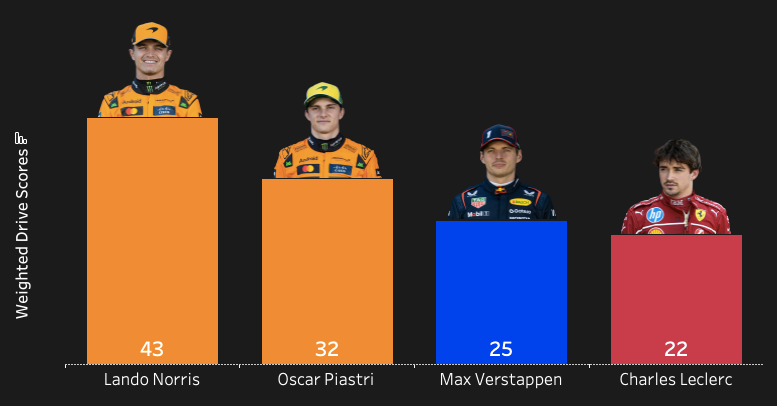
Heading into the race, our prediction was clear: Norris to take the victory, with Piastri, Verstappen, and Leclerc all strong podium threats.
Join Data Punk Media today and explore the different data stories we publish.
The Race Recap
Under the lights of Marina Bay, the Singapore Grand Prix delivered a controlled but high-stakes race from start to finish. The lights went out at 8:00 p.m. local time with George Russell starting from pole position, and he never looked back. Russell executed a flawless launch, building a steady gap early and maintaining command for the entire 62-lap race.
Behind him, the action unfolded quickly. Lando Norris got an exceptional start, leaping from fifth to third within the opening turns after an aggressive move past both Kimi Antonelli and his McLaren teammate Oscar Piastri. The maneuver came at a cost – Norris clipped the back of Max Verstappen’s car and sustained minor front wing damage, though it wasn’t enough to compromise his pace. The incident was briefly reviewed by the stewards but ultimately deemed a fair racing move, allowing Norris to hold position.
From there, the race settled into a rhythm, with Russell, Verstappen, and Norris occupying the top three spots for most of the evening, while Piastri held a consistent fourth. Most teams opted for a medium-to-hard one-stop strategy, resulting in minimal order changes outside of pit windows.
In the final 16 laps following a yellow flag, Verstappen came under renewed pressure from Norris as the McLaren driver closed the gap to within striking distance. Despite the late challenge, Verstappen held firm to secure second place, finishing just over five seconds behind Russell, who claimed his first Singapore Grand Prix victory with a final time of 1:40:22.367.
The State of the Grid
The battle for the Drivers’ Championship is intensifying as the season nears its conclusion. Our updated visuals highlight the leaders, track the shifts in the standings, and show who remains mathematically in contention. With Abu Dhabi looming, every point could make the difference in crowning this season’s champion.
With his third-place finish in Singapore, Lando Norris narrowed the gap in the Drivers’ Championship, gaining three points on Oscar Piastri, who still leads by 22. Max Verstappen’s second-place finish kept him within striking distance, but with the McLaren duo continuing to trade podiums, the title fight increasingly looks set to come down to the two teammates.
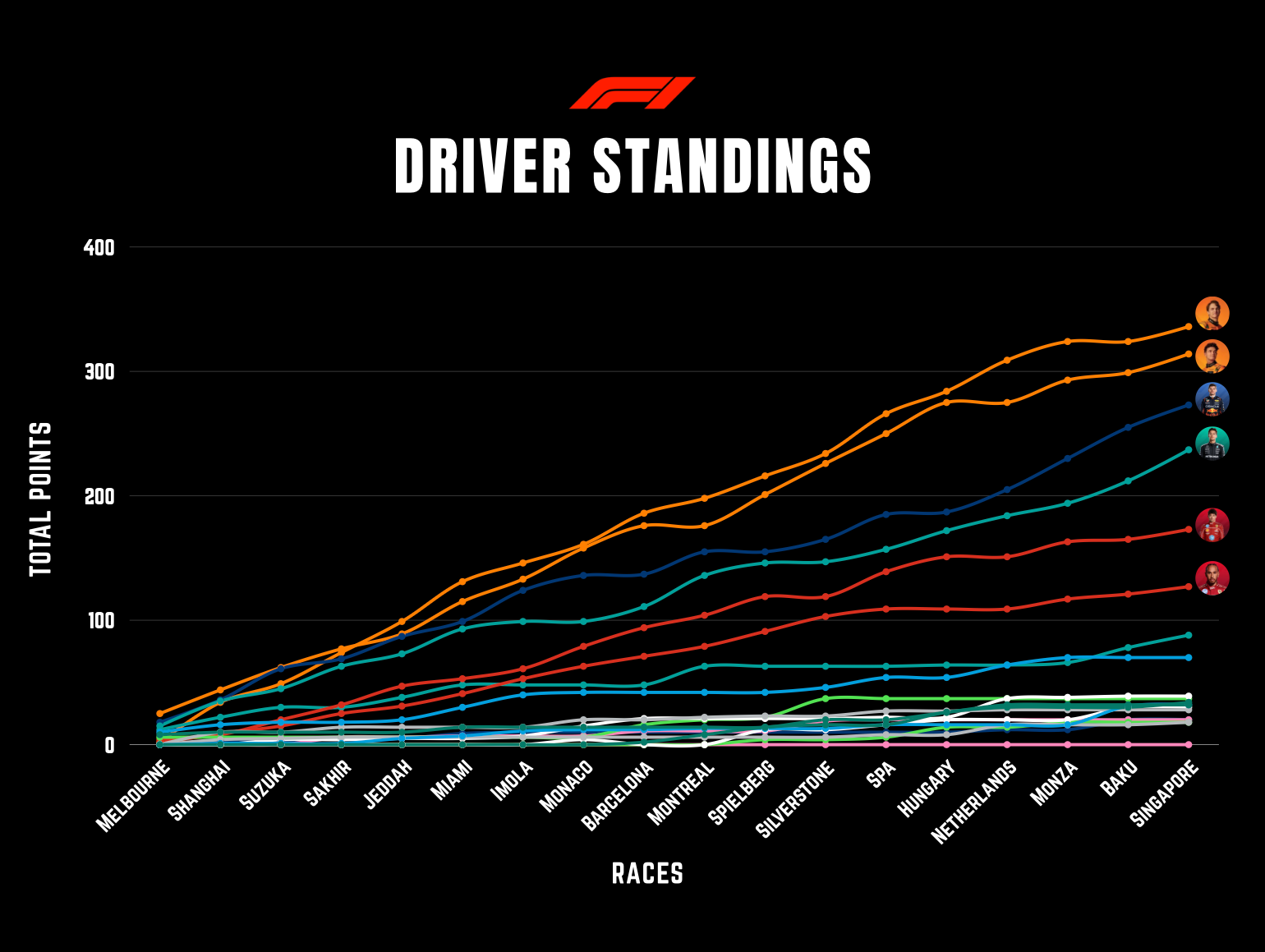
McLaren was able to clinch the Constructors’ Championship for the second consecutive year, marking their 10th title overall and tying the record for the earliest championship win in a season – with six races still remaining – a milestone first set by Red Bull in 2023. While McLaren’s dominance has been decisive, the battle for second remains wide open, with Mercedes, Ferrari, and Red Bull separated by just 35 points as the season heads into its final stretch.
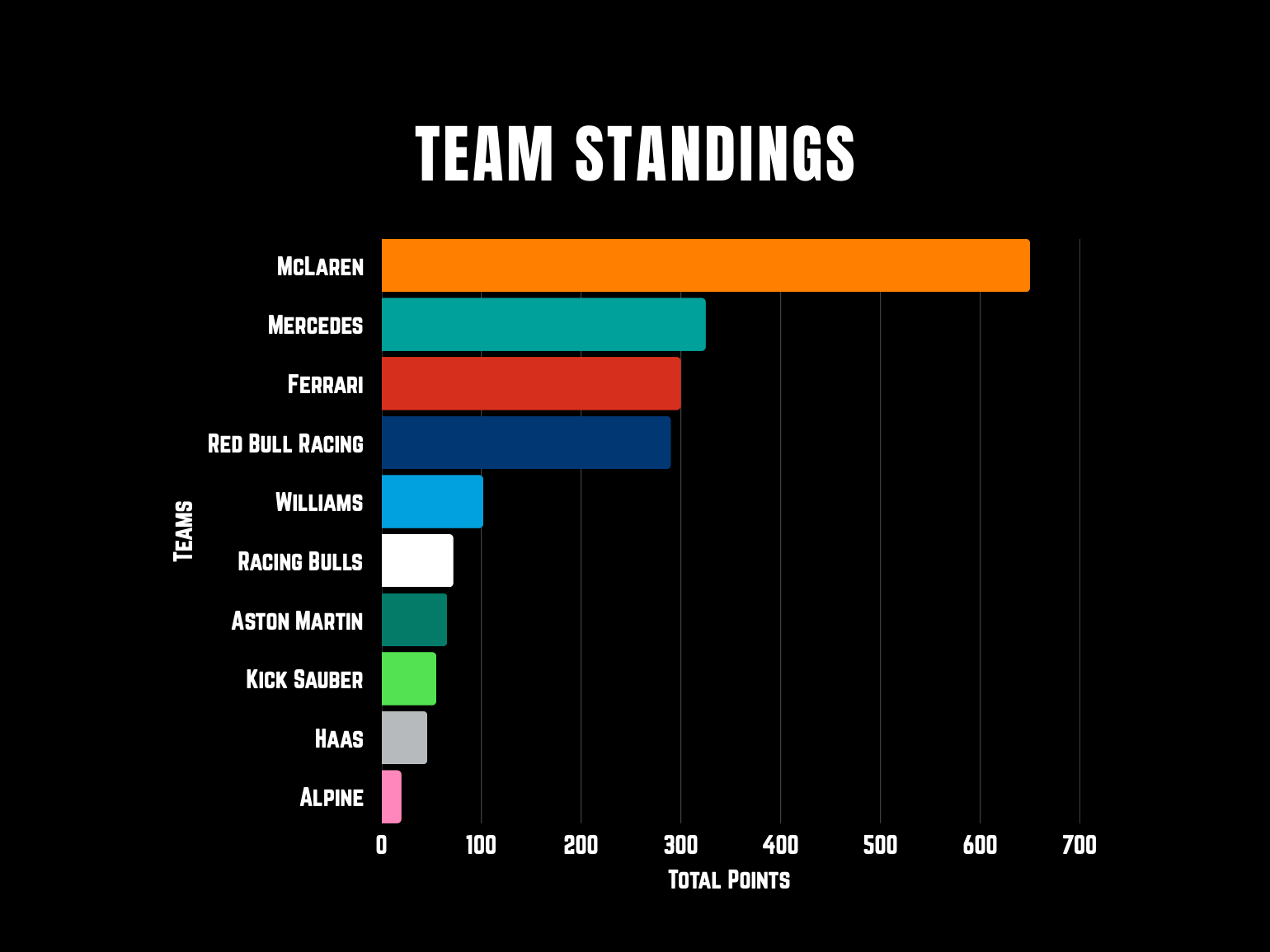
Interested in data-backed stories? Check out all our series at Monthly Stories.
Looking Ahead: The Next Race
In our next story, we’ll dive into the high-stakes battle for supremacy at the Circuit of the Americas (COTA) ahead of the Austin, Texas race on Sunday, October 19th. Lewis Hamilton built his legacy here with five wins (2012, 2014, 2015, 2016, 2017), but Max Verstappen has stormed in with three consecutive victories (2021, 2022, 2023), threatening to rewrite history.
Who will claim the Texas crown this time? Will Hamilton defend his throne, or has Verstappen’s COTA reign just begun? We’ll break down the data, track records, and performance trends to find out, stay tuned!


